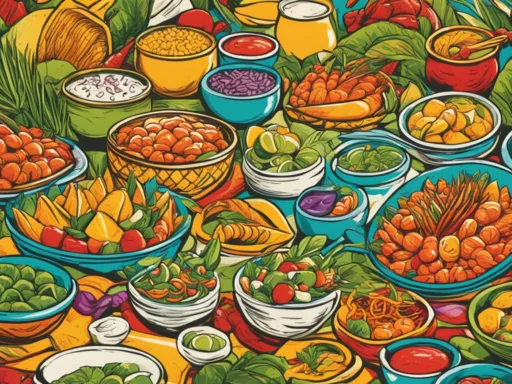Embark on a delectable Yemeni Food Journey that will tantalize your taste buds like never before. Imagine a cuisine so varied and rich, it traces the flavor-filled footsteps of Arabian caravans, captures the zesty essence of South Asian spices, and echoes the culinary traditions of East Africa. Ever wondered how one country’s fare could weave such a vivid tapestry of cultural connections? Prepare to dive into the heart of Yemeni cuisine, a hidden gem in the gastronomic world, where every dish tells a unique story of heritage and hospitality.
From the spiced layers of aromatic Mandi to the comforting hug of Saltah stew, discover traditional Yemeni recipes that not only promise an explosion of flavor with every spoonful but also provide a window into the soul of Yemen’s deep cultural landscape. It’s time to whet your appetite and ready your senses for a culinary escapade that promises to be as enlightening as it is delightful.
Key Takeaways
- Embark on a flavorful exploration of the rich and diverse traditions behind Yemeni cuisine.
- Understand how cultural influences from across continents have shaped traditional Yemeni recipes.
- Appreciate the significance of hospitality reflected in every aspect of a Yemeni Food Journey.
- Discover how Mandi and Saltah, iconic dishes of Yemen, encapsulate the essence of heartwarming Yemeni hospitality.
- Gain insight into the deep connection between Yemen’s culinary practices and its cultural heritage.
Yemeni Food Journey: An Introduction to Authentic Flavors
Embarking on a Yemeni food journey unveils a world where each dish tells a profound story of history, geography, and communal bonds. Renowned for its richly flavored and heartily spiced meals, the tapestry of Yemeni culinary culture offers a palette of experiences that excite the senses and envelop the soul with warmth reminiscent of its ancient roots.
The Historical Tapestry of Yemeni Culinary Culture
Delving into Yemeni culinary culture is akin to exploring a living museum of gastronomy, where the flavors are as old as the trade routes that passed through its lands. From turmeric and myrrh to the piercing fragrance of frankincense, the scent of Yemeni spices guides one through the lanes of historical markets and into the homes where traditional recipes were nurtured over generations.
Signature Ingredients of Yemeni Gastronomy
In the scent-laden kitchens of Yemen, a tapestry of ingredients comes together to craft the staples of its cuisine. Earthy legumes, piquant spices, and grains like rice form the cornerstone, while proteins such as lamb speak of the heartiness within authentic Yemeni food. Rich, creamy yogurt and the vibrant kick of fresh herbs and spices complete the symphony, manifesting in every spoonful the spirit of Yemen’s food identity.
The Role of Spices in Yemeni Cuisine
What truly defines the fabric of this distinctive cuisine is the intricate use of spices. One couldn’t possibly speak of Yemeni culinary culture without a reverent nod to the likes of cumin, coriander, cinnamon, and cloves. These are not mere additions to a recipe; they are the embodiment of Yemen’s history, its environment, and, most importantly, its people. The delicate balance of these spices within Yemeni cuisine conjures an authentic flavor profile that is at once complex, traditional, and profoundly satisfying.
Delving into the Richness of Yemeni Staples
Yemen’s culinary heritage is a tapestry woven from the threads of rich flavor profiles and time-tested traditions. The heartiness of Yemeni dishes is encapsulated in every serving of the country’s staple foods. As we highlight select dishes on our Yemeni food blog, it’s evident that from savory main courses to sweet indulgences, every recipe is an ode to the land’s diverse palette.
One can hardly discuss Yemeni cuisine without praising the beloved Mandi. This dish is a celebration of rice and meat coming together under the influence of a special blend of spices. It represents the essence of Yemeni gatherings and feasts. Furthermore, for those seeking comfort in a bowl, the Saltah stew is nothing short of culinary harmony with its meat, vegetables, and fenugreek froth.
Turning the spotlight to vegetarian options, Ful Medames provides an experience brimming with flavor and nutrition. It’s a testament to the versatility of Yemeni cuisine, ensuring that there’s something for everyone. For carnivores, the Yemeni Kebabs—marinated in rich spices and grilled to perfection—are a sumptuous treat not to be overlooked.
Finally, Yemeni cuisine offers an array of desserts that not only satisfy the sweet tooth but also narrate a history of cross-cultural influences. From the semolina-based Basbousa to the layered pastry delight known as Bint Al-Sahn, these desserts are a fitting closure to any Yemeni meal.
| Dish | Main Ingredients | Vegetarian |
|---|---|---|
| Mandi | Rice, lamb or chicken, special Mandi spices | No |
| Saltah | Beef or lamb, vegetables, fenugreek froth | No |
| Ful Medames | Fava beans, garlic, olive oil | Yes |
| Yemeni Kebabs | Lamb or chicken, spices | No |
| Basbousa | Semolina, coconut, syrup | Yes |
| Bint Al-Sahn | Dough, honey, nigella seeds | Yes |
Exploring the multitude of Yemeni dishes is akin to embarking on a sensory journey through Yemen’s valleys and mountaintops. Each dish, with its unique blend of ingredients and preparation methods, tells a story of the land and its people. Our Yemeni food blog seeks to unveil these rich, delectable stories, encouraging foodies everywhere to savor this culinary richness firsthand.
Traditional Yemeni Recipes: A Gateway to Cultural Heritage
Yemeni cuisine is a reflection of the country’s rich history, intertwining ancient cooking traditions with a blend of spices that transport you through centuries. Lamb is often the centerpiece in traditional Yemeni dishes, prepared using time-honored Yemeni cooking techniques that have been passed down through generations. Here’s a closer look at the beloved meat dishes, vegetarian specials, and famous Yemeni bread that tell a story of cultural identity and communal life.
Iconic Meat Dishes of Yemen
Yemen’s meat dishes such as Mandi, which features tender, spiced meat served over fragrant rice, are not just meals but celebrations of the hospitality known to the region. Another treasure, Fahsa, delights with its tender chunks of lamb cooked in a clay pot, capturing the essence of local flavors.
Vegetarian Yemeni Dishes and Their Significance
Despite a strong presence of meat dishes, Yemen’s culinary scene also presents rich vegetarian options. Ful Medames, a comforting fava bean stew, epitomizes the adaptability of Yemeni flavors, offering a wholesome alternative that remains steeped in the same cultural authenticity as its meat-based counterparts.
Yemeni Bread Varieties: Khobz and Beyond
In Yemen, bread is a staple that completes every meal. Khobz, a traditional Yemeni bread, is often baked in a tandoor and serves as the perfect vessel for scooping up the bold flavors found in stews and dips. Each loaf is a testament to the artisanal craft and an intrinsic part of daily life across Yemen.

By exploring the depths of Yemen’s culinary practices, one can appreciate the intricate layers of taste and the enduring customs that define traditional Yemeni recipes. As old as the ancient lands themselves, the legacy of Yemeni dishes carries forward the stories of a warm and welcoming culture, deeply connected to their roots and the aromatic kitchens that fuel it.
The Diversity of Yemeni Cuisine Across Regions
The rich tapestry of Yemeni cuisine unveils a panorama of flavors that are shaped by the country’s diverse geographies. From the seafood-rich offerings along the Arabian Sea and Red Sea coasts to the hearty, spice-laden dishes of the mountainous inland, each region contributes to the full spectrum of Yemeni culinary variations. Exploring these regional Yemeni dishes provides an insightful glimpse into the local cultures and traditions that pulsate through the nation’s food.
Coastal Influences on Yemeni Culinary Practices
Yemen’s coastal regions, like Aden and Hudaydah, lean heavily on their proximity to rich maritime resources, infusing their diet with a variety of seafood. This dependency on the ocean’s bounty is historical and directly influences the local palate, where fish, shrimp, and crab often take center stage. The cooking methods vary from grilling over open flames to simmering in fragrant, spiced broths.
Mountainous Flavors: Unique Regional Variations
Rising above the coastline, the highland areas of Yemen tell a different story—where the elevation and climate conjure a distinct set of ingredients and techniques. Indigenous spices and herbs, some found only in these elevated enclaves, lead to bold taste profiles that differ markedly from their coastal counterparts. The use of stone terracing for agriculture also plays into the unique flavors cultivated in these regions.
| Region | Key Ingredients | Typical Dishes | Cooking Techniques |
|---|---|---|---|
| Coastal Areas | Seafood, Rice, Cilantro | Mukbasa (Seafood Rice), Shafut (Yogurt Salad) | Grilling, Simmering |
| Mountainous Regions | Lamb, Stone-grown Spices, Fenugreek | Salta (Meat Stew), Bint Al-Sahn (Honey Cake) | Baking in Clay Ovens, Steaming |
In savoring the array of regional Yemeni dishes, one appreciates the complex interplay between land, sea, and tradition. With every dish served, the Yemeni culinary variations tell stories of adaptation and creativity—a testament to Yemen’s multifaceted identity.
Yemeni Cooking Techniques: Traditions Preserved Through Time
The art of Yemeni cooking techniques captures the essence of an authentic Yemeni food journey. These ancient practices are the keepers of flavor, where every sear, simmer, and spice carries with it the legacy of generations past. Cherishing these time-honored methods is akin to preserving the spirit of traditional Yemeni recipes, which are renowned for their ability to bring communities together in a celebration of cultural identity.
One of the most distinguished culinary methods is the use of tandoor, a type of oven essential in creating the famous dish Mandi. The tandoor’s unique cooking environment infuses the meat with an unforgettable smokiness, which is why Mandi stands out as a prime example of the traditional delicacies found on a Yemeni food journey. The tandoor is but one of the many tools utilized in Yemeni kitchens that reflect a history rich in gastronomic ingenuity.

With a focus on these methods, one can begin to understand the layers of flavors and the meticulous attention to detail required to produce such heartwarming and authentic Yemeni food. To further illustrate, a comparison of traditional Yemeni cooking tools and their functions has been detailed below.
| Yemeni Cooking Tool | Primary Use | Significance in Yemeni Cuisine |
|---|---|---|
| Tandoor Oven | Slow-cooking meats, roasting bread | Provides a distinct smoky flavor and tender texture |
| Madra (Clay Pot) | Simmering stews and soups | Enhances spice infusion and depth of flavor |
| Mortar and Pestle | Grinding spices | Releases natural oils and aromas for robust taste |
| Flat Griddle (Mehmas) | Cooking flatbreads | Produces a crisp exterior while maintaining a soft center |
The preservation of these methods stands as a testament to the enduring nature of Yemeni culinary traditions. As one indulges in dishes crafted using these ancient techniques, they not only experience gastronomic pleasure but also partake in the storied journey of Yemen’s rich cultural tapestry.
Authentic Yemeni Food Beyond the Main Courses
When exploring the robust palates of Yemeni cuisine, the adventure extends far beyond the staple rice and meat to include a variety of savory snacks and indulgent Yemeni desserts. Each bite-sized delight and sweet treat encapsulates the rich culinary traditions of Yemen, offering a broader taste of the country’s diverse gastronomic landscape.
Savory Snacks and Street Foods of Yemen
In the bustling streets of Yemen’s cities, one can discover a world of flavorful bites. Sambusas, the triangular pastry filled with meat or vegetables, are a must-try, and their crispy exterior gives way to a fragrant, spicy center that’s emblematic of Yemeni dishes on-the-go. Another street food favorite is the succulent Kebabs, grilled over open flames, filling the air with the alluring aroma of spices and cooked meats.
Sweet Treats: Exploring Yemeni Desserts
To conclude a meal, or perhaps to sweeten a gathering amongst friends, Yemeni desserts offer comfort and joy in every spoonful. Delicacies such as Sahlab, a warming milky pudding sprinkled with cinnamon, and Zalabia, deep-fried dough coated in syrup, are treasures of the local cuisine, representing the soulful and inviting nature of Yemeni hospitality.

| Snack | Main Ingredients | Description |
|---|---|---|
| Sambusas | Ground meat or vegetables, dough, spices | A deep-fried pastry with a savory filling, enjoyed as a popular street snack |
| Yemeni Kebabs | Meat (often lamb), spices, vegetables | Skewered meat cooked over flames, known for its smoky flavor and tender texture |
| Sahlab | Milk, sugar, cornstarch, cinnamon | A comforting dessert beverage thickened with cornstarch and flavored with cinnamon |
| Zalabia | Dough, sugar syrup, yeast | Sweet, deep-fried dough balls drizzled with fragrant syrup, a staple Yemeni sweet treat |
Sampling the collection of savory and sweet staples reveals a full spectrum of Yemeni cuisine, where every dish is a story of culture, history, and the shared joy of food.
Yemeni Spices: The Soul of Their Cuisine
Unveiling the essence of traditional Yemeni cooking techniques, the elaborate use of Yemeni spices is more than just a practice—it’s an art form that infuses life into every dish. From the aromatic alleys of Sana’a to the bustling markets of Aden, spices form the cornerstone of a rich and diverse culinary tradition. Yemeni spices do more than add flavor; they create an experience, evoking memories and emotions with each savory bite, a true testament to the indelible mark they leave on the culinary landscape.
The medley of spices used in Yemeni cuisine is reflective of the historical trade routes that once threaded through the nation. Exploring a Yemeni food blog, one discovers how these spices are masterfully blended to produce tastes that are both complex and harmonious. Cinnamon, cardamom, cloves, and cumin are just a few of the familiar characters in an ensemble that plays out a symphony of flavors, distinct to this part of the Arabian Peninsula.
| Spice | Typical Usage | Flavor Profile |
|---|---|---|
| Cinnamon | Added to rice dishes like Mandi | Warm and sweet with a woody fragrance |
| Cardamom | Ground into coffee and desserts | Intensely aromatic with a resinous complexity |
| Cloves | Seasoning for meats and stews | Pungent and sweetly piquant. |
| Cumin | Base for spice mixes and rubs | Earthy, with a slightly bitter undertone |
Integral to Yemeni cooking techniques, spices are not just sprinkled but carefully woven into the fabric of each dish, ensuring that every layer of flavor is as intentional as it is delightful. Unique spice blends such as Hawayij and Zhug bring both warmth and heat to the table, embodying the bold spirit of Yemeni people and their passion for life and food.
- Hawayij: A mix used liberally in soups and stews, distinguished by its balanced blend of turmeric, cumin, coriander, and black peppercorns.
- Zhug: A fiery companion to many Yemeni meals, crafted from fresh green chilies, coriander, garlic, and various spices.
In this sumptuous sphere of Yemeni spices, each meal is an invitation to explore the landscape of a nation rich in history and flavor, a journey chronicled in every post of a devoted Yemeni food blog. As the spice-laden breeze whispers through the nation’s rugged terrain, it carries with it the stories of generations, narrated through the magic of its cuisine.
Exploring the Yemeni Food Blog Scene
The Yemeni food blog sphere is a bustling digital hub teeming with rich, authentic stories. It’s a place where the myriad flavors of Yemeni culinary culture are told through the experiences of those who cherish it the most—its dedicated bloggers. With a love for sharing Yemeni culinary stories, these bloggers have created an invaluable resource for anyone curious about the traditional and modern twists of Yemeni gastronomy.
Sharing Yemeni Culinary Stories
Each post and photo shared is a stitch in the fabric of Yemen’s rich gastronomic tapestry. From heartfelt tales of family recipes passed down through generations to explorations of contemporary Yemeni dishes that fuse old-world charm with new-age sensibilities, these blogs are more than just about food. They preserve and celebrate a culture as old as time, bringing it to the forefront of the global digital community.
Top Yemeni Food Bloggers to Follow
The Yemeni food blog landscape is littered with knowledgeable and passionate food connoisseurs. Here’s a curated list of notable bloggers who are worth following for their insightful commentary and delectable recipes:
| Blog Name | Focus Area | Specialty Dish Highlight |
|---|---|---|
| The Spiced Kitchen | Traditional Recipes | Saltah |
| Yemeni Pot | Street Food and Snacks | Samboosa |
| Gourmet Yemen | Modern Takes on Classics | Fusion Mandi |
| Queen of Sheba’s Table | Regional Specialties | Zurbian |
| Honey & Cardamom | Desserts and Sweets | Bint Al-Sahn |
By following these talented bloggers, you not only get to explore the treasures of Yemeni culinary culture but also support the voices that are keeping the country’s flavorful heritage alive in these challenging times. Whether you’re in it for the love of food or the stories behind the dishes, diving into the Yemeni food blog scene promises a journey replete with spice-laden memories and heartwarming hospitality.
Conclusion
Embarking on a Yemeni food journey offers more than just the exploration of flavors and dishes; it is an intimate expedition into the heart of Yemeni culture and history. Traditional Yemeni recipes are the threads that weave the rich tapestry showcasing Yemen’s diverse influence from Arabian, Indian, and African gastronomies. Each meal is a testament to the harmonious blend of spices and ingredients that have been carefully curated over centuries.
Embarking on Your Yemeni Food Journey
Diving into the vibrant world of Yemeni cuisine introduces enthusiasts to a culinary tradition that is robust yet evolving. The quest to understand Yemeni food is an ever-expanding adventure, ripe with hearty stews, aromatic spices, and succulent meats. Whether savoring the smoky nuances of Mandi, the comforting warmth of Saltah, or the sweet layers of Bint Al-Sahn, your palate is set to experience an unmatched gastronomic delight. Each bite reaffirms the uniqueness of Yemeni cuisine, a jewel in the crown of global culinary treasures.
The Continuous Evolution of Yemeni Culinary Tradition
As with any living tradition, Yemeni cuisine continues to adapt and flourish amidst the changing tides of time. The dishes that have delighted for generations serve as both a foundation and inspiration for future creations. Yemen’s culinary landscape, rich with traditional Yemeni recipes, is a beacon for both the preservation of heritage and the celebration of new interpretations. This continuous evolution is what makes the Yemeni food journey endlessly engaging, inviting food connoisseurs to revisit and rediscover the tastes that make this cuisine stand apart.






